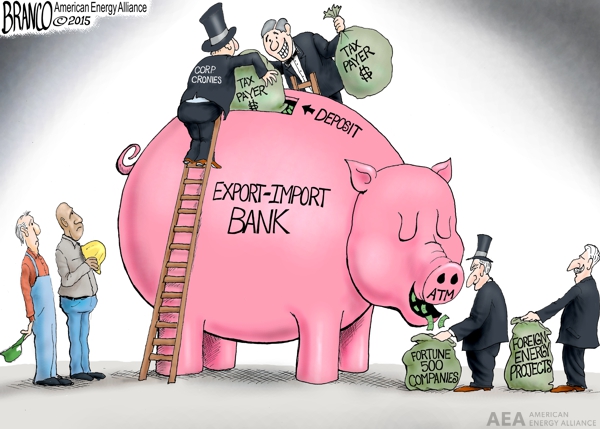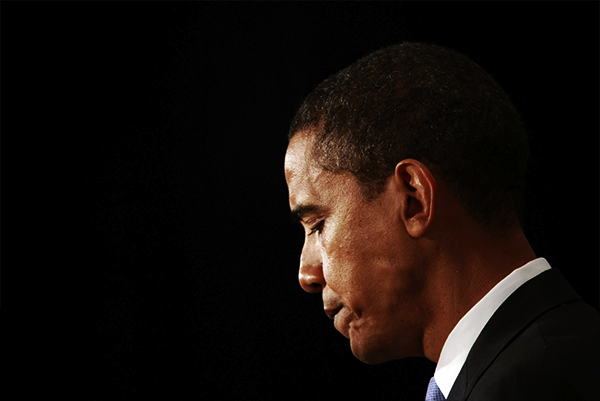Congress Moves to Revive Obama’s Green Energy Piggybank

As the battle over the Senate’s objectionable tax extenders package continues, another fight over special interests and corporate welfare is building in Congress—namely, the reauthorization of the Export-Import (Ex-Im) Bank. After Ex-Im’s mandate expired on June 30, senators voted Sunday to revive the Bank.
The U.S. government runs the bank as its “official export credit agency.” It provides a way for the government to back up projects that the private sector is purportedly unwilling to undertake by shifting the risk onto taxpayers. Although Ex-Im currently cannot forge any new deals, it can still execute the $112 billion already in its portfolio.
By risking billions in taxpayer dollars on numerous questionable deals, the Obama administration has utilized the bank to promote its green energy agenda. The end result is significant damage to small businesses and American families.
Ex-Im Makes the Playing Field Unfair
While the bank is regularly touted as an effective way to fill in the gaps that the private sector leaves behind and counteract subsidies from foreign nations, The Wall Street Journal provides a compelling explanation of why this isn’t the case:
But Ex-Im has been subsidizing credit for so long that it’s impossible to know if those “gaps” would be filled if Ex-Im went away. Everything we know about markets says they largely would. Boeing, Ex-Im’s biggest beneficiary, has already said it can secure alternative financing. General Electric doesn’t lack for bankers. The Government Accountability Office (GAO) looked at Ex-Im in 2013 and said the bank “cannot answer the question of what would have happened without Ex-Im financing.” Maybe that’s because it didn’t want to.
A careful look at the numbers reveals the same conclusion. According to the Mercatus Center at George Mason University, Ex-Im backs only a small percentage of total U.S. exports and merely of a sliver of that is directed toward leveling the playing field for U.S. companies. Furthermore, its actions distort the market and actually make it harder for other U.S. companies to compete with subsidized ones.
And Ex-Im isn’t profitable. If the bank used fair-value instead of government accounting, its top programs would put taxpayers $2 billion in the red. Taxpayers have only taken on more risk as Ex-Im’s financial exposure increased by more than $36 billion over the last four years.
Ex-Im Supports Green Energy Cronyism
Due to Ex-Im’s mandate to support renewable energy, the bank provided billions in subsidies to projects that support the administration’s green energy agenda. Among these deals have been some spectacular failures. Here are a few examples:
- Solyndra: Ex-Im approved a $10 million loan guarantee to a Belgian bank that financed the purchase of solar panels from Solyndra, a firm tied to the Obama administration that went bankrupt after leaving taxpayers on the hook for hundreds of millions of dollars.
- Exports In Name Only: Ex-Im approved subsidies for a company to sell solar panels to itself and call it an “export,” a Washington Examiner investigation revealed. The bank issued $455.7 million in loan guarantees for a Canadian company, St. Clair Solar, to buy solar panels from First Solar. The problem: First Solar owns St. Clair—so First Solar shipped solar panels to itself, taxpayers subsidized the sale, and Ex-Im called it an “export.”
- Double Dipping: As Mercatus points out, several large energy companies, some of which are foreign-owned, have received taxpayer subsidies from multiple federal programs in addition to handouts from Ex-Im. Examples include:
- Gamesa, a Spanish wind firm: $1.3 billion total (including Ex-Im).
- Areva, a French nuclear company: $2.1 billion.
- Abengoa, a solar and biofuel conglomerate: $3 billion.
Further, the Ex-Im bank has been tied to Brazilian industrial magnate Marcelo Odebrecht, who was recently arrested on corruption charges. Diane Katz of The Heritage Foundation points out instances of Petrobras receiving Ex-Im handouts:
1998, for example, the Ex-Im board conferred “delegated authority” on Petrobras to issue up to $100 million in loan insurance and guarantees backed by the bank. Other deals include:
- January/May 2001: $44 million in financing for Petrobras to purchase a steam turbine and generator from General Electric for a power plant project. Four months later, the loan amount was increased to $97 million.
- October 2001: A $178 million loan to buy gas turbines and other equipment for a power plant project involving Petrobras and two other companies.
- May 2005: A $39 million loan guarantee for equipment to build an oil production platform for Petrobras off the coast of Brazil.
- 2009: A preliminary commitment of $2 billion to Petrobras as part of the bank’s “proactive outreach.” The financing was intended to develop offshore oil and gas reserves and upgrade its refining and distribution infrastructure. (This financing coincided with the Obama administration’s restrictions on offshore oil and gas projects.)
- February 2010: A $308 million loan guarantee to a Petrobras subsidiary for oil and gas field development. Bank records show $100 million is still outstanding.
- 2012: A $23 million loan guarantee to a Brazilian firm that will supply helicopter services to Petrobras for its deep-water drilling rigs.
While the Ex-Im bank was busy financing to the corruption-troubled Petrobras in Brazil, the Obama administration has made it more difficult for American oil companies to obtain offshore drilling permits in the U.S.
Conclusion
AEA has issued a key vote alert urging Congress to reject any attempt to reauthorize the Ex-Im Bank. Sadly, most of the Senate opted to side with President Obama’s green energy agenda over American families. Congress should prevent the extension of an agency that harms taxpayers by leaving them on the hook for costly green energy programs and other forms of corporate welfare.




